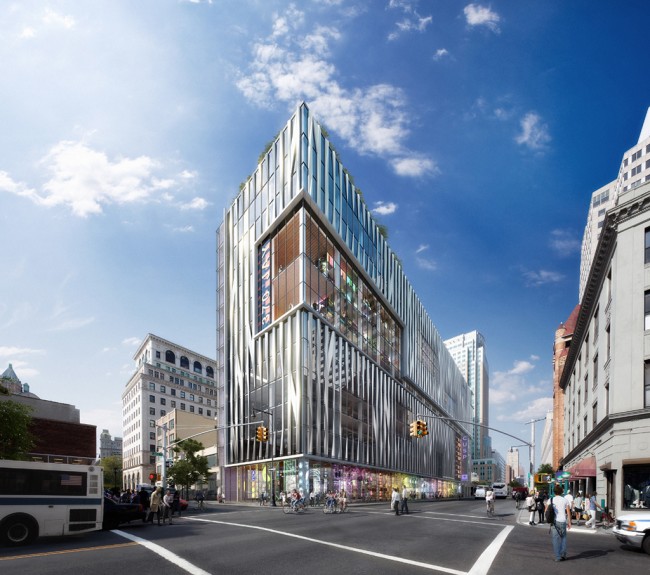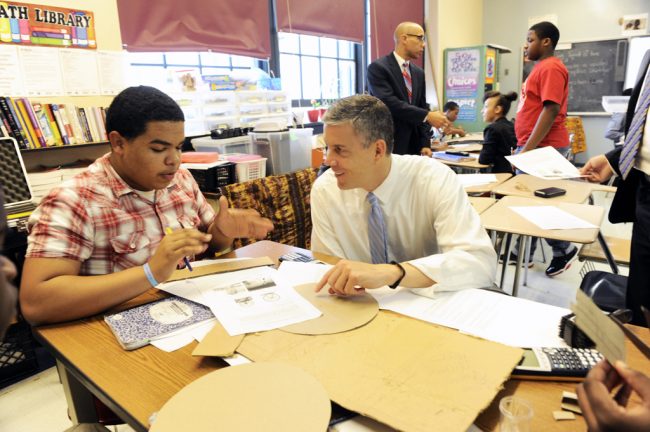
We are celebrating 15 years — and counting — of stories that are deeply researched and deeply felt, that build a historical record of what the city has been.
We are celebrating 15 years — and counting — of stories that are deeply researched and deeply felt, that build a historical record of what the city has been.

Rendering of CUSP’s future home in Downtown Brooklyn | Image via NYC EDC
New York City Mayor Michael Bloomberg is a long-time proponent of the power of data and technology to deliver useful, actionable information across all categories of professional fields and environments. He became a billionaire by applying such techniques to the financial industry and has brought this data-driven approach to city governance, propagating a narrative of data analysis’ potential to improve efficiency and enhance public life. Among the chief examples of this potential, the City’s Office of Policy and Strategic Planning, dubbed the “geek squad,” harnesses existing municipal data to optimize traffic flows, predict locations of crime, and efficiently target buildings for inspection. Acknowledging the growing application of data in city management and concurrent growth in industry interest in the field, the City is also investing in academic centers committed to studying this data, among them New York University’s new Center for Urban Science and Progress (CUSP).
Designed as a public-private initiative distinct from traditional academia, CUSP sports a long and influential list of partners: beyond the City and NYU, the center is joined by six international academic institutions; industry leaders in architecture, engineering, and computer science including IBM, Microsoft, Cisco, Siemens, AECOM, and ARUP; and four national research laboratories. CUSP’s industry partners play an especially integral role in the initiative’s development: the companies are shaping new classes offered through the graduate program and a year-long internship with an industry partner on a project devised with CUSP is a major component of the curriculum. Through such research and graduate studies, the center aims to become the world’s leading authority on urban informatics, an emerging field defined by CUSP as the collection, integration, management, and analysis of data to improve urban systems and quality of life.
The symposium “Urban Informatics and the Keys to the Future City,” held recently by CUSP and IBM, provided a look into what the future of the center might hold. While the talks were largely advertisements of the successes of CUSP and IBM, unfortunately foregoing true critical examination of their programs, the examples of IBM’s work and CUSP’s approach to the field provided were nonetheless compelling.

U.S. Secretary of Education Arne Duncan visits with Josian Estrella at P-TECH | Image via IBM Photo
The first panel highlighted an existing IBM program at the high school level in Crown Heights, Brooklyn: Pathways in Technology Early College High School (P-TECH), which seeks to equip students with skills needed to compete in today’s cities by providing them the opportunity to earn an associates degree while in high school. IBM’s Smarter Cities initiatives — on which CUSP students will work — were also on display, among them an index of worldwide water prices meant to spur private investment in local water infrastructure by allowing investors to more effectively calculate risk.
Another example of a tool under the Smarter Cities umbrella is Deep Thunder, IBM’s initiative to couple weather data with historical damage information and complex topographical imaging of the city to inform disaster response. The promise of the program lies in its ability to predict the hyper-local effects of weather events with a lead time of days instead of hours. How the model is able to predict weather far earlier than others using the same data collection points was not clear, but the implications of a successful Deep Thunder are significant. IBM envisions an improved ability to streamline aid to hard-hit areas, mitigate sewer overflows, and evacuate residents to safety. But good prediction does not always lead to effective action: evacuation orders can go unheeded — often a consequence of unconsummated predictions of the past, a perhaps solvable issue — and political wrangling can stymie efficient distribution of aid regardless of lead time.
This disconnect between potential and implementation, according to CUSP Deputy Director Constantine Kontokosta, is a fundamental challenge and motivation for this type of program. Kontokosta sees CUSP as an experiment in how cities, academia, and industry can work together to inform policy and foster innovation for the public good. The challenge for CUSP as an institution and for the leaders it aims to produce is the management of the vastly different cultures, approaches, and motivations of these three sectors. Translating industry innovations, developed through CUSP’s projects with industry partners and meant at least in part to be monetized, into improvements in the quality of life for a city’s citizens is an endeavor fraught with competing priorities. As Adam Greenfield notes in his new pamphlet “Against the smart city” (an excerpt of which can be found here on UO), the rhetoric of some of the companies involved with CUSP tends to privilege the interests of the already powerful, in industry or government, over the well-being of the general public. Kontokosta spoke of a need for balancing these interests, noting that while optimization and efficiency may be valid concerns in the delivery of city services, using data deterministically in pursuit of these goals inhibits proper governance. According to Kontokosta, data should instead be made available publicly — fodder for further technological and policy developments — to empower all in the broader civic process.
While CUSP and IBM touted their roles as a promising incubator for data-driven ideas, the symposium implied another crucial component of urban informatics as a field of academic study: to investigate the implications of this data collection and analysis on urban life and to explore who these systems ultimately benefit. The public-private nature of CUSP is both its greatest challenge and its source of greatest potential. As it leverages a variety of approaches, CUSP must remain committed to the citizens it hopes to serve.
The views expressed here are those of the authors only and do not reflect the position of The Architectural League of New York.